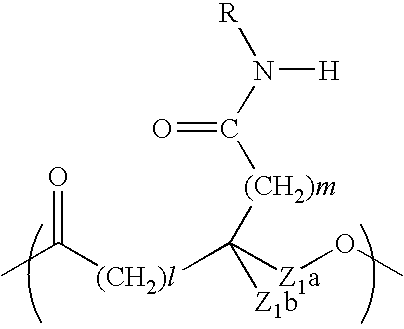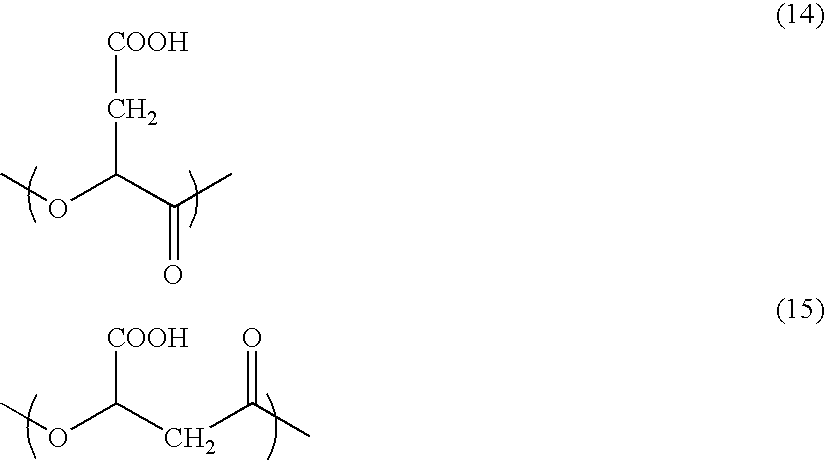Resin-coated carrier for electrophotographic developer
- Summary
- Abstract
- Description
- Claims
- Application Information
AI Technical Summary
Benefits of technology
Problems solved by technology
Method used
Image
Examples
examples
[0265] Hereinafter, the present invention will be described in more detail by way of examples. The term “part” in Examples means “part by weight”. First, a toner and a polyhydroxyalkanoate used in Examples were produced according to the following method.
Toner Production Example 1
[0266] Styrene-acrylic acid-dimethylaminoethyl 2-ethyl hexyl methacrylate copolymer (copolymerization ratio=80:15:5) [0267] 100 parts by weight [0268] Copper phthalocyanine pigment [0269] 5 parts by weight [0270] Low-molecular-weight polypropylene [0271] 4 parts by weight
[0272] The above respective materials were sufficiently premixed, and the mixture was melted and kneaded. After having been cooled, the kneaded product was coarsely pulverized by means of a hammer mill in an average particle diameter of about 1 to 2 mm. Then, the coarsely pulverized product was finely pulverized by means of an air jet classifier. Furthermore, the finely pulverized product was classified by means of an elbow jet classifier...
preparation example a-1
Synthesis of Polyester Using 3,6-di(3-butenyl)-1,4-dioxane-2,5-dione and L-lactide
[0279] 0.11 g (0.5 mmol) of 3,6-di(3-butenyl)-1,4-dioxane-2,5-dione, 0.65 g (4.5 mmol) of L-lactide, 2 ml of a solution of 0.01 M of tin octylate(tin 2-ethylhexanoate) in toluene, and 2 ml of a solution of 0.01 M of p-tert-butylbenzyl alcohol in toluene were placed in a polymerization ampule, and the whole was dried under reduced pressure for 1 hour and replaced with nitrogen. After that, the ampule was heat-sealed under reduced pressure and heated to 150° C. to perform ring-opening polymerization. 1 hour after that, the reaction was terminated, and the ampule was cooled. The resultant polymer was dissolved into chloroform, and reprecipitated in methanol in an amount 10 times that of chloroform necessary for the dissolution. The precipitate was collected and dried under reduced pressure to prepare 0.63 g of a polymer.
[0280] NMR analysis was performed under the following conditions to determine the st...
preparation example a-2
[0288] Oxidation reaction of polyhydroxyalkanoate composed of unit represented by chemical formula (24) synthesized in Preparation Example A-1
[0289] 0.50 g of the polyhydroxyalkanoate copolymer composed of the unit represented by the chemical formula (24) synthesized in Preparation Example A-1 (A: 9 mol %, B: 91 mol %) was placed in a round-bottomed flask, and 30 ml of acetone were added to dissolve this. The flask was placed in an ice bath, 5 ml of acetic acid and 0.47 g of 18-crown-6-ether were added, and the whole was stirred. Next, 0.38 g of potassium permanganate was gradually added to the flask in the ice bath, and the whole was stirred in the ice bath for 2 hours and stirred at room temperature for an additional 18 hours. After the completion of the reaction, 60 ml of ethyl acetate were added, and 45 ml of water were further added. Next, sodium hydrogen sulfite was added until peracid was removed. After that, liquid property was adjusted with 1.0N hydrochloric acid to have a...
PUM
 Login to View More
Login to View More Abstract
Description
Claims
Application Information
 Login to View More
Login to View More - R&D
- Intellectual Property
- Life Sciences
- Materials
- Tech Scout
- Unparalleled Data Quality
- Higher Quality Content
- 60% Fewer Hallucinations
Browse by: Latest US Patents, China's latest patents, Technical Efficacy Thesaurus, Application Domain, Technology Topic, Popular Technical Reports.
© 2025 PatSnap. All rights reserved.Legal|Privacy policy|Modern Slavery Act Transparency Statement|Sitemap|About US| Contact US: help@patsnap.com



